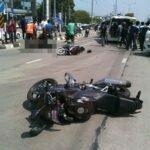For persons experiencing heat stroke, the Department of Medical Services (DMS) has published first aid protocols.
Due to disturbing yearly reports of heat stroke-related mortality in Thailand between the months of March and May from 2015 to 2019, the recommendations were released. 43 deaths are reported yearly on average.
Due to global warming, heat stroke has become a problem in several nations, including the United States, France, and Japan. Dr. Thongchai Kiratihatthayakorn, director-general of DMS, claims that heat stroke is a medical emergency that happens when the body is unable to control its internal temperature. High body temperatures may result from this, which may harm the muscles, heart, brain, and other important organs.

Little children, the elderly, athletes, soldiers, and anybody laboring in hot, muggy circumstances are among the groups at higher risk for heat stroke. Heat stroke can also be brought on by some medications, including anticonvulsants, opioids, and psychiatric medications.
A body temperature over 40.5°C, confusion or seizures brought on by abnormal neurological system activity, and hot, dry skin brought on by the body’s inability to produce perspiration to cool down are only a few of the signs of heat stroke identified by Lerdsin Hospital.
A damp cloth should be placed on the body of anyone displaying these symptoms, they should be transported to a shady area with good air circulation, all unneeded clothes should be removed to allow heat dissipation, and they should phone the emergency number 1669 for prompt medical assistance.
Avoiding direct sunlight and hot settings, dressing in loose-fitting, light-colored clothes that promotes adequate air circulation, and drinking lots of water are all important steps in preventing heat stroke.
To avoid the warmest part of the day, outdoor activities should be planned for the morning or evening. Also, it is crucial to refrain from drinking alcohol before or while engaging in outdoor activities because it can make you feel hotter.





